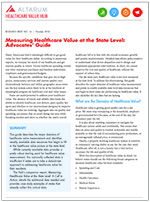Measuring Healthcare Value at the State Level: Advocates' Guide
Many Americans find it alarmingly difficult to get good value for their healthcare dollar. According to numerous reports, we overpay for much of our healthcare and get uneven quality in return. Excess healthcare spending crowds out other important purchases and burdens individuals, employers and governmental budgets.
Because the specific conditions that give rise to high prices, unnecessary services and uneven quality vary tremendously between and within geographic areas states are the key system actors likely to be at the forefront of meaningful progress on healthcare cost and value issues.
States are underpowered to address poor healthcare value. The absence of timely and reliable data limits the ability to identify healthcare cost drivers, poor-quality hot spots and whether or not interventions designed to improve healthcare value are working. Aggregate data on quality and spending can ensure that we aren’t fixing one area while breaking another and show us whether the state’s overall healthcare bill is in line with the overall economic growth and quality improvements. Detailed data enables policymakers to understand what drives disparities and to design and implement appropriate interventions. In short, we cannot improve the cost and quality of healthcare without the support of robust data.
For the most part, healthcare value is not now measured at the state level. To address this shortcoming, this guide describes the major domains of healthcare value measurement and points to readily available state-level data resources that can begin to show states are performing on healthcare value. It also identifies the key data that are lacking.







